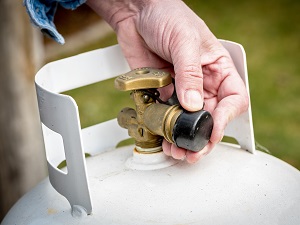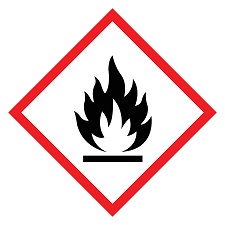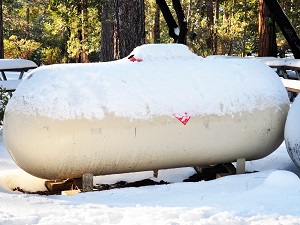Propane is a safe, efficient, and reliable fuel often used on the job but it must be handled, transported, and stored properly or it can be dangerous.

Propane is a hazardous flammable material that can have explosive force if ignited because the container is pressurized. If there is a leak, the propane can be ignited and cause a fire or burn the worker handling the container. Propane containers can also leak over time creating a fire hazard. Propane cylinders should not be stored in enclosed, unventilated work areas.
Propane is a colorless, odorless gas when pure or it may have a faint petroleum-like odor. A foul-smelling odorant is added to propane, especially when it is used for fuel purposes.
If you see a white fog or smell gas, it’s a sign of a leak. It’s unlikely, but if it should happen, close the valve on the propane container, evacuate the area, and call the local fire department for help.
Adequate training must be provided to all workers who may handle propane cylinders or work near propane tanks. Appropriate PPE, especially eye and hand protection, should be worn when connecting and disconnecting propane to or from hoses.

Take care when choosing a storage location for propane cylinders. The containers should not be located in any area that has a risk of experiencing excessive heat, tampering by unauthorized persons, or physical damage by passing or falling objects. Propane cylinders should not be stored (even temporarily) near exits, stairways, or any other high-traffic areas.
OSHA Standard 1910.110(f)(2)(ii) Containers when stored inside shall not be located near exits, stairways, or in areas normally used or intended for the safe exit of people.
It’s best to store propane cylinders at least 20 feet away from the building in an area that is protected from rain, like an open-air cage with floor and a roof. Protect stored propane cylinders from falling by using a support system, like a chain. Consider securing each container individually for easy and safe removal.
OSHA Standard 1926.153(o) When damage to LP-Gas systems from vehicular traffic is a possibility, precautions against such damage shall be taken.
Propane cylinders should be placed in a such a way that the relief valve is in direct contact with the vapor space in the container. Propane cylinders may generally be stored in a vertical position. When propane cylinders used to fuel forklifts are placed horizontally the relief device must be at the top.

Propane containers should not be stored near other flammable or combustible materials. Do not store or use propane cylinders in an area of excessive heat or near a heat or ignition source like open flames or pilot lights. Ambient temperatures in storage areas should not exceed 125° F. Ensure fire extinguishers are placed within easy access of propane storage.
OSHA Standard 1926.153(h)(10) Containers, regulating equipment, manifolds, pipe, tubing, and hose shall be located to minimize exposure to high temperatures or physical damage.
Do not smoke while handling, transporting, or working near propane containers and do not use metal tools when changing a cylinder. Ensure there are no ignition sources in areas where propane is being stored or is in use which includes spark-producing power tools.
OSHA Standard 1910.110(f)(2)(i) Containers in storage shall be located so as to minimize exposure to excessive temperature rise, physical damage, or tampering by unauthorized persons.
Propane cylinders are often painted light or reflective colors to reduce heat absorption from the sun. Do not paint propane containers a dark color. Never attempt to cut open, modify, repair, or disassemble any parts of a propane container.
When not in use, the valve on the propane container should be closed to avoid a potential leak. Do not use excessive force when opening or closing the valve.

Inspect propane cylinders regularly and look for signs of defects, deep rusting, and leakage. If propane cylinders are in poor condition they should be replaced, even if they haven’t yet met their requalification date. Do not use a damaged, expired, or leaking propane cylinder. Propane cylinders past their requalification date must be replaced or exchanged.
OSHA Standard 1910.101(a) Each employer shall determine that compressed gas cylinders under his control are in a safe condition to the extent that this can be determined by visual inspection.
Use a leak detector or a soap solution to check for the location of suspected leaks. (½ water and ½ liquid dish soap brushed on the connections where bubbles will indicate a leak.) Never use a lit match to check for leaks.
OSHA Standard 1926.153(n) When LP-Gas and one or more other gases are stored or used in the same area, the containers shall be marked to identify their content. Marking shall be in compliance with American National Standard Z48.1-1954, "Method of Marking Portable Compressed Gas Containers To Identify the Material Contained."
Propane contracts when it’s cold and may result in low pressure in the container. In cold weather climates it is recommended that the propane containers be kept at least 30% full at all times to keep the pressure higher.
Ice and snow should be cleared from the regulators, vents, and valves to prevent damage that could cause a gas leak. To find the tank in heavy snow, consider putting a flag or pole next to the tank to show the location.

Carry and transport propane cylinders in a vertical position, with the valves closed. Propane cylinders should not be rolled, dropped, dragged along the floor, or allowed to bang against other objects.
When transporting a propane cylinder in a vehicle, it’s generally okay to lay it down but it’s always best to keep it standing up and secured, if possible. Never ask a passenger to hold onto a propane container. Always transport propane cylinders in the trunk or cargo area of the vehicle.
It is best if the propane containers have some amount of ventilation while being transported. The propane cylinders must not be left inside a closed vehicle during hot weather if there is a chance of excessive heat build-up.
Always follow the manufacturer’s instructions for any propane-powered tools and equipment including proper use, inspection, storage, and the cylinder-changing procedure. Never leave propane-fueled tools or equipment (including forklifts) unattended in any area of possible excessive heat or near ignition sources.
Carefully follow the instructions in the owner’s manual regarding locations of safe operation. Exhaust from propane-fueled equipment contains poisonous carbon monoxide and should only be used in well-ventilated or outdoor areas only.

.jpeg)

.jpeg)